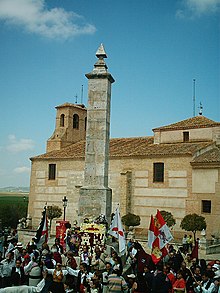Battle of Villalar
This article includes a list of general references, but it lacks sufficient corresponding inline citations. (April 2011) |
| Battle of Villalar | |||||||
|---|---|---|---|---|---|---|---|
| Part of the Revolt of the Comuneros | |||||||
 A 19th century work by Manuel Picolo López depicting the Battle of Villalar. | |||||||
| |||||||
| Belligerents | |||||||
| Royalist Castilians | Comuneros | ||||||
| Commanders and leaders | |||||||
|
Íñigo Fernández |
Juan Bravo (POW) | ||||||
| Strength | |||||||
|
8,400 men
|
7,400 men
| ||||||
| Casualties and losses | |||||||
| 20–30 dead | 500–1,000 dead | ||||||
The Battle of Villalar was a battle in the
Background
Maneuvers in March and April 1521
In late March 1521, the royalist side moved to combine their armies and threaten
Battle
The Royalist army pursued the Comuneros. As had been the case through most of the war, the Royalists had a strong advantage in cavalry, with their army consisting of 6,000 infantry and 2,400 cavalry against Padilla's 7,000 infantry and 400 cavalry. Heavy rain slowed Padilla's infantry more than the royalist cavalry and rendered the primitive firearms of the rebels' 1,000
The Comuneros set up their artillery to try to blunt the cavalry charge, but this failed. According to some reports, the artillery did more damage to the comuneros than the royalist cavalry. Sources[who?] differ on the reasons behind this. According to the account of Pedro de Alcocer (a friend of the Padillas), the Comuneros were betrayed; the artillery and some 300 soldiers had been bought off by the royalists prior to the battle, and switched sides. The artillery intentionally fired high and destroyed their powder. A slightly more subdued theory blames the rain for the ineffectiveness of the Comunero artillery. Finally, it is possible that in the heat of the battle, the artillerymen simply panicked and made mistakes.[citation needed]

The cavalry charges scattered the rebel ranks thus ending the battle and becoming a slaughter. There were an estimated 500–1,000 rebel casualties and many desertions. The three most important leaders of the rebellion were captured:
Aftermath

Demoralized, and without leaders or an army, the rebel cities of Old Castile soon surrendered to the Constable's armies. It took slightly longer for the Constable's armies to march south to New Castile and retake Madrid. They likely would have taken Toledo as well, but a French invasion of Spanish-controlled Navarre meant that the army needed to immediately be recalled north to fight the French and Navarrese. As a result, the Revolt stretched out several months more, with Toledo resisting until October.
Legacy
The Battle of Villalar would later be claimed by Spanish liberals as the blow that extinguished Castilian liberties in favor of autocratic Spanish monarchy. This view started in the 1820s, as Juan Martín Díez "El Empecinado", a nationalistic liberal military leader during the Peninsular War, led an expedition to find and exhume the remains of the three Castilian leaders executed in 1521. Later, some city councils called for celebrations at Villalar in the 1920s. After the end of Franco's dictatorship, this view became more generalized. The autonomous community of Castile and León made 23 April the official holiday of Castile and León Day in 1986, although it had been popularly celebrated since 1976. It is celebrated yearly at Villalar, which has since the Second Spanish Republic renamed itself Villalar de los Comuneros, honouring the Castilian rebels.
Notes
- ^ Pérez 2001, p. 110.
- ^ a b Seaver 1928, pp. 324–325.
- ^ Pérez 2001, p. 111.
References
- ISBN 0-299-08500-7.
- ISBN 84-323-0285-6.
- ISBN 84-9734-003-5.
- Seaver, Henry Latimer (1966) [1928]. The Great Revolt in Castile: A Study of the Comunero Movement of 1520–1521. New York: Octagon Books.
